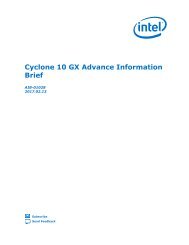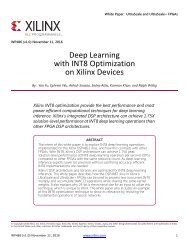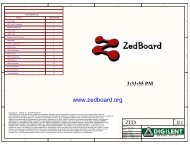UltraScale Architecture Memory Resources
ug573-ultrascale-memory-resources
ug573-ultrascale-memory-resources
Create successful ePaper yourself
Turn your PDF publications into a flip-book with our unique Google optimized e-Paper software.
Chapter 1: Block RAM <strong>Resources</strong><br />
Table 1-2: True Dual-Port Functions and Descriptions (Cont’d)<br />
Port Function<br />
Description<br />
RSTRAM[A|B]<br />
CLK[A|B]<br />
DOUT[A|B]<br />
DOUTP[A|B] (1)<br />
REGCE[A|B]<br />
CASDIN[A|B]<br />
CASDINP[A|B]<br />
CASDOUT[A|B]<br />
CASDOUTP[A|B]<br />
SLEEP<br />
Read Operation<br />
In latch mode, the read operation uses one clock edge. The read address is registered on<br />
the read port, and the stored data is loaded into the output latches after the RAM access<br />
time. When using the output register, the read operation takes one extra latency cycle.<br />
Write Operation<br />
A write operation is a single clock-edge operation. The write address is registered on the<br />
write port, and the data input is stored in memory.<br />
Write Modes<br />
Synchronous set/reset of the output data latches.<br />
Clock input.<br />
Data output bus.<br />
Data output parity bus. Can be used for additional data outputs.<br />
Output register clock enable.<br />
Cascade data input bus.<br />
Cascade parity input bus.<br />
Cascade data output bus.<br />
Cascade parity output bus.<br />
Dynamic shutdown power saving. If SLEEP is active, the block is in power saving<br />
mode.<br />
Notes:<br />
1. Data-In Buses – DINADIN, DINPADINP, DINBDIN, and DINPBDINP, page 31 has more information on data parity<br />
pins.<br />
2. Block RAM primitive port names can be different from the port function names.<br />
3. For a more complete cascade data flow and port descriptions, see Cascadable Block RAM, page 16 and Block RAM<br />
Library Primitives, page 24.<br />
Three settings of the write mode determine the behavior of the data available on the output<br />
latches after a write clock edge: WRITE_FIRST, READ_FIRST, and NO_CHANGE. Write mode<br />
selection is set by configuration. The write mode attribute can be individually selected for<br />
each port. The default mode is WRITE_FIRST. WRITE_FIRST outputs the newly written data<br />
onto the output bus. READ_FIRST outputs the previously stored data while new data is<br />
being written. NO_CHANGE maintains the output previously generated by a read operation.<br />
<strong>UltraScale</strong> <strong>Architecture</strong> <strong>Memory</strong> <strong>Resources</strong> www.xilinx.com<br />
Send Feedback<br />
11<br />
UG573 (v1.2) February 24, 2015











